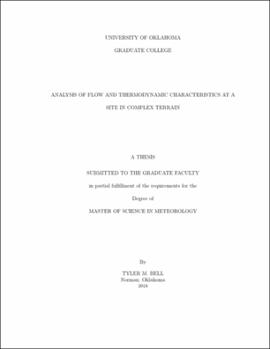| dc.description.abstract | The goal of the Perdigão Field Experiment was to study atmospheric flows in complex terrain and to collect a high-quality dataset for the validation of meso- and micro-scale models. An Intensive Observation Period (IOP) was conducted from May 1, 2017 through June 15, 2017 where a multitude of instruments was deployed in and around two nearly parallel, 5 km long ridges separated by a 1.4 km wide valley perpendicular to the prevalent wind directions in the region. During this IOP, the Collaborative Lower Atmospheric Mobile Profiling System (CLAMPS) was deployed and operated in the valley between the ridges. The CLAMPS facility, which was developed as a joint effort between the School of Meteorology at OU and NOAA’s National Severe Storms Laboratory (NSSL), utilizes a microwave radiometer (MWR), an atmospheric emitted radiance interferometer (AERI), and a scanning Doppler lidar (DL) to profile the boundary layer with a high temporal and spatial resolution. Optimized DL scanning strategies and joint retrievals for the MWR and AERI data provide detailed information about the wind, turbulence and thermodynamic structure from the surface up to 1000 m AGL on most nights; profiles can extend higher depending on aerosol concentrations and cloud cover. Over the course of the IOP, CLAMPS observed many different phenomena. During some nights, with stronger prevailing winds that were directed perpendicular to the valley, waves were observed at the ridges and in the valley. At the same time, radiational cooling led to katabatic flows in the valley, particularly during nights when synoptic scale forcing was weak.
% Numerous DLs were strategically placed to capture flow features above the ridges and in the valley. The arrangement of DLs presented an opportunity to create virtual towers where Range Height Indicator (RHI) scans of individual instruments intersected. CLAMPS performed both cross- and along-valley RHI scans every 15 minutes. The Technical University of Denmark (DTU) operated eight Leosphere Windcube 200S scanning DLs upgraded with DTU’s WindScanner software and the German Aerospace Center (DLR) contributed three DLs of the same kind. Many of these DLs performed cross-valley RHI scans that intersected with the along-valley RHI scan from OU. Four virtual towers distributed along the valley could be retrieved every 15 minutes where the RHIs intersect. The virtual towers typically cover heights from 50m to 600m above the valley floor, extending the range of traditional in-situ observations located throughout the valley. Additionally, they fill in low altitude areas where other DL processing techniques (such as VADs or DBS scans) may have trouble retrieving accurate wind speeds due to the high spatial flow variability and prevalence of significant vertical motions in complex terrain. Along with the wind speed and direction, uncertainties associated with the DLs were propagated through the retrieval. A case study will be presented to highlight the usefulness of these virtual towers.
In addition to CLAMPS, the Technical University of Denmark (DTU) operated eight Leosphere Windcube 200S scanning DLs and the German Aerospace Center (DLR) contributed three DLs of the same kind to capture flow features above the ridges and in the valley. The arrangement of DLs presented an opportunity to retrieve four virtual towers every 15 minutes where Range Height Indicator (RHI) scans of individual instruments intersected. The virtual towers typically encompassed heights from 50 m to 600 m above the valley floor, extending the range of traditional in-situ observations located throughout the valley. Additionally, they provide data in low altitude areas where other DL processing techniques (such as Velocity Azimuth Displays or Doppler Beam Swinging scans) may have trouble retrieving accurate wind speeds due to the high spatial flow variability and prevalence of significant vertical motions in complex terrain. Along with the wind speed and direction, uncertainties associated with the DLs were propagated through the retrieval. A few case studies will be presented to highlight the usefulness of these virtual towers. | en_US |
